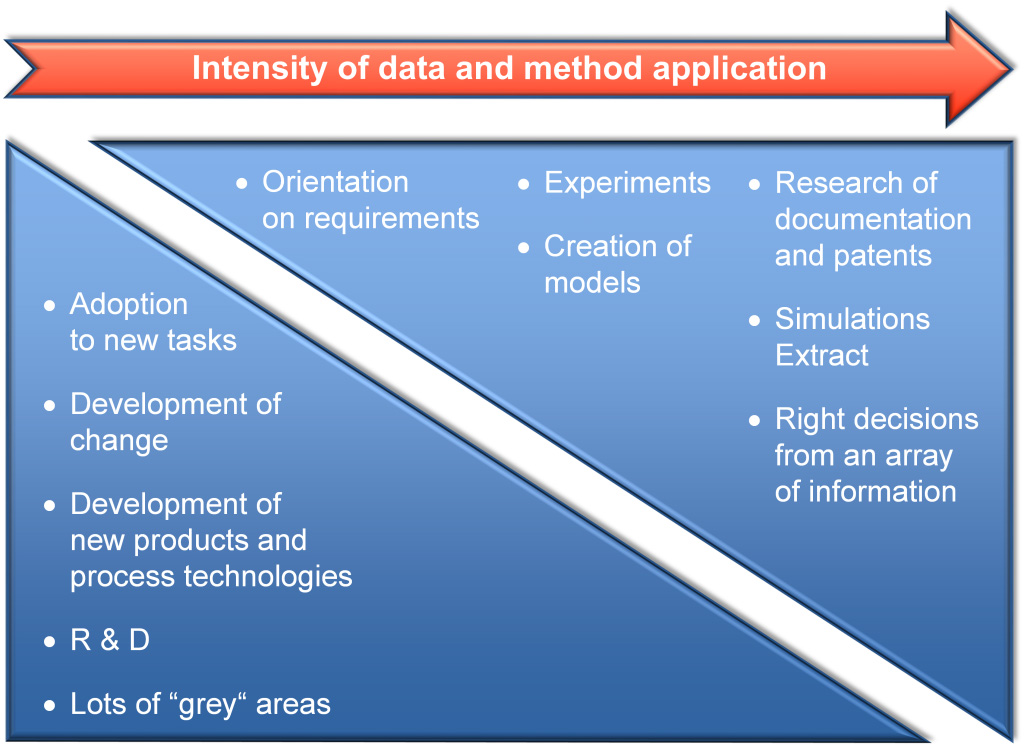Design for Six Sigma (DFSS) is a targeted and causal approach to develop products and/or processes in whole or in part. DFSS combines the actual development work with methodology and data analysis. The objective is to develop products and/or processes as prompted all external and internal customers and to ensure a smooth running of a new series. The technical and methodological angles of DFSS are interactive with a required target cost.
Whereas there are various models having all the same goals, we opted for the so-called DMADV approach.

What are the key requirements and expectations on this DFSS project, what should be designed and why?
- Create a Development Strategy
- Set targets and product idea
- Develop the Business case
- Plan and define a Project plan
- Define ressources and gates
- Create an evaluation
- Create a communication plan
- Define/ fix target costs
These informations are the base for a design of alternative concepts.
- Collect and compile the customer’s requirements
- Prioritize and translate the requirements into CTS`s (specific and measurable customer requirements), specify target values and tolerances if possible
- Transform CTS’s into functional requirements
- Develop alternative design concepts
- Introduction into the creative toolbox
- Basics of TRIZ
- Identify performance and functionality
- Calculate the complexity
- Estimate risks (based on data)
- Determine costs
- Identify and assess critical elements in design and construction
- Analyze essential critical couplings
- Develop a concept selection matrix and select the best concept
- Pugh concept selection
- Optimize and finalize the concept
- Create specifications
- Determination of all necessary product components
- QFD – House of Quality (1+2)
- Data based FMEA for Product design
- Functional analysis
- Basics of the statistics
- Graphical data analysis
- Overview about the common performance indicators
- Planning of trials and measurements and development of hypothetical transfer functions
- Regression analysis, Basic-Roadmap
- Introduction into the analysis of variance (ANOVA), Basic-Roadmap
- Overview about statistical tests, Basic-Roadmap
- Design Score Cards
- Introduction into Design of Experiments (DoE), Basic-Roadmap
- Evaluation of the relevant transfer functions (Y = f (x))
- Optimal parameterization and tolerance setting
- Basics of tolerancing
- Ensure the robustness of the design
- Test/measurement and sampling strategy
- Demonstrate a robust product design
- Introduction into reliability analysis
There is a prosecution of the causal chain of DFSS into the process design and the elementary inputs are the product specification and all further requirements existing.
If it is necessary to start a new design of any process then it needs to be started:
- Determine the required process capabilities and comparison with the existing processes
- Systematic generation of process design concepts
- Analysis of the concepts related to
- Functionality / performance
- Complexity
- Risks
- Costs
- Malfunctions
- Elementary couplings
- Optimization and finalization of the best concept
- Axiomatic process design, detailed phase
- Determination of all necessary process components
- Design Scorecards 3+4
- Process Modelling (DoE or Data Mining))
- Evaluation of the relevant transfer functions (y = f (x))
- Evaluation of optimal parameters
- Machine – and Process Qualification
- Process FMEA with data based interfaces
- Functional analysis for process designs
Development of hypothetical process transfer functions
- Evaluation of the relevant process transfer functions (Y=f(x))
- Design of a process control concept suitable for the future production
- Measurement and sampling strategy, Basic-Roadmap
- Development of the required control concept for later production
- Measurement system analysis (MSA), Basis-Roadmap
- Evaluation/review the product – and process performance
- Demonstrate and proof life cycle and reliability
- Evaluation/review of the purchased part and supplier capabilities
- Review of the development order
- Finalize and project and production documentation
- Delivery of the product and/or process design to production
- R&D handover on the base of appropriate agreed KPIs
- Hand over to series production
As already mentioned, under DFSS there are different approaches, which ultimately all have the same goal, namely to realize the serial production of new products and / or processes as smoothly as possible and with minimum losses.
Where and to what extent it is applied, depends on the task of a project and usually also of various operating conditions. Our DFSS – Roadmap adapts to your choices, expectations and restrictions – as it covers DFSS Light, (if needed for administrative development projects) up to the integration of data mining for data-intensive projects for all project cases.
In the definition of the relevant entry and exit point and the establishment of a meaningful approach, we are happy to assist you.

